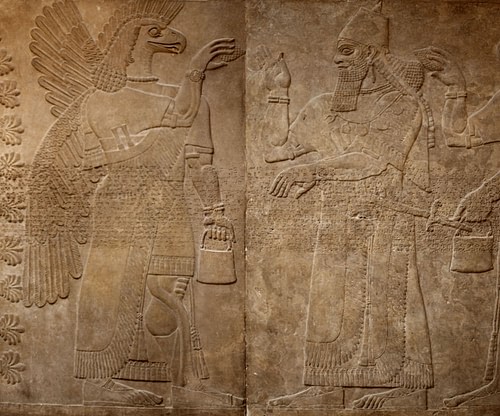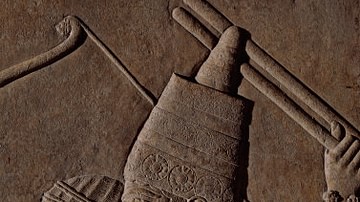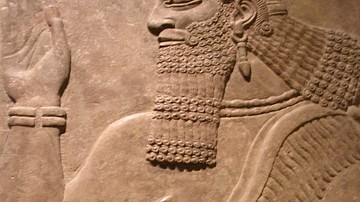The foundation of the Assyrian dynasty can be traced to Zulilu, who is said to have lived after Bel-kap-kapu (c. 1900 BCE), the ancestor of Shalmaneser I. The city-state of Ashur rose to prominence in northern Mesopotamia, founding trade colonies in Cappadocia. King Shamshi-Adad I (1813-1791 BCE) expanded the domains of Ashur by defeating the kingdom of Mari, thus creating the first Assyrian kingdom.
With the rise of Hammurabi of Babylonia (c. 1728–1686 BCE) and his alliance with Mari, Assyria was conquered and reduced to a vassal state of Babylon.
Middle Assyrian Period
In the 15th century BCE, Hurrians from Mitanni sacked Ashur and made Assyria a vassal. When Mitanni collapsed under pressure from the Hittites in Anatolia, Ashur again rose to power under Ashur-uballit I (1365-1330 BCE). He married his daughter to the Kassite ruler of Babylon with disastrous results: The Kassite faction in Babylon murdered the king and placed a pretender on the throne. Ashur-uballit promptly marched into Babylonia and avenged his son-in-law.
Shalmaneser I (1274-1245 BCE) declared that Assyria was no longer a vassal of Babylon and claimed supremacy over western Asia. He fought the Hittites in Anatolia, conquered Carchemish, and established more colonies in Cappadocia. His son Tukulti-Ninurta I (reigned 1243–1207 BCE) conquered Babylon, putting its King Bitilyasu to death, and thereby made Assyria the dominant power in Mesopotamia. He ruled at Babylon for seven years and assumed the old imperial title "king of Sumer and Akkad". During a Babylonian revolt, he was murdered by his son, Ashur-nadin-apli. Babylon was once more independent from Assyria.
Tiglath-pileser I (1114-1076 BCE), one of the great conquerors of Assyria, extended the remaining empire to Armenia in the north and Cappadocia in the west. He hunted wild bulls in Lebanon and was presented with a crocodile by the Egyptian pharaoh.
Little is known of Tiglath-pileser's direct successors, and it is with Ashurnasirpal II (883-858 BCE) that our knowledge of Assyrian history continues. The empire of Assyria was again extended in all directions, and the palaces, temples, and other buildings raised by Ashurnasirpal II bear witness to a considerable development of wealth and art. Nimrud (also known as the Biblical city of Calah or Kalakh) became the favorite residence of the monarch, who was distinguished even among Assyrian conquerors for his revolting cruelties. His son, Shalmaneser II (1031-1019 BCE) continued the expansion of Assyria and even further militarized the country.
When Nabu-nazir ascended the throne of Babylon in 747 BCE, Assyria was in the throes of a revolution. In 746 BCE Calah joined the rebels, and the rebel leader Pulu took the name of Tiglath-pileser III, seized the crown, and inaugurated a new and vigorous policy.
During the Middle Assyrian Period, the cities of Ashur, Nimrud, and Nineveh rose to prominence in the Tigris River valley. Babylon remained the most important and probably the largest city of the period.
Neo-Assyrian Empire
Under Tiglath-pileser III (ruled 745-727 BCE) the Neo-Assyrian Empire arose, which differed from the first in its greater consolidation. For the first time in history the idea of centralization was introduced into politics; the conquered provinces were organized under an elaborate bureaucracy, with each district paying a fixed tribute and providing a military contingent.
The Assyrian forces became a standing army creating an irresistible fighting machine. Assyrian policy became geared towards conquering the known world. With this goal in mind, Tiglath-pileser III secured the high-roads of commerce to the Mediterranean together with the Phoenician seaports and then made himself master of Babylonia. In 729 BCE, the summit of his ambition was attained, and he was invested with the sovereignty of Asia in the holy city of Babylon. With his conquest of Israel (745-727 BCE), the first wave of Israelite deportations had begun.
Tiglath-pileser was succeded by his son Shalmaneser V (reigned 727-722 BCE) who died shortly after. The throne was seized by the general Sargon II (ruled 722-705 BCE), who conquered the Hittie stronghold of Carchemish and annexed Ecbatana. He was seen as the successor of Sargon of Akkad. His son Sennacherib (ruled 704-681 BCE) was a less skilled king who was never crowned in Babylon and eventually destroyed the holy city. Under his reign, Nineveh was built to become a new center of Assyrian power, famed for its library of cuneiform tablets. His reign, though, was one of terror, and upon his assassination both his subjects and enemies were relieved.
Esarhaddon (ruled 681-669 BCE) succeesed Sennacherib and restored Babylon to its former glory, making it the second capital of the Assyrian empire. In 674 BCE he sent the Assyrian armies to invade Egypt which was subsequently conquered. Two years later the Egyptians revolted and in his march to deal with the revolt, he fell ill and died.
Ashurbanipal (685-627 BCE) succeeded him as king of the Assyrian Empire, and his brother Samas-sum-yukin was made viceroy in Babylonia. The arrangement failed, as Samas-sum-yukin did not prove to be popular with the Babylonians who revolted. After several years of war, during which Egypt regained its independence with the help of mercenaries sent by Gyges of Lydia, the Babylonian rebellion was put down. Shortly after, Elam rebelled, its capital Susa was razed, and the Empire was finally drained of all its resources.
The Scythians and Cimmerians invaded Assyria from the east and from the north, and when Ashurbanipal died, his Empire was close to collapse under external pressure. The Babylonian king Nabopolassar (ruled 625-605 BCE), along with Cyaxares of the Medes (ruled 625-585 BCE) finally destroyed Nineveh in 612 BCE, marking the end of the Assyrian Empire.















